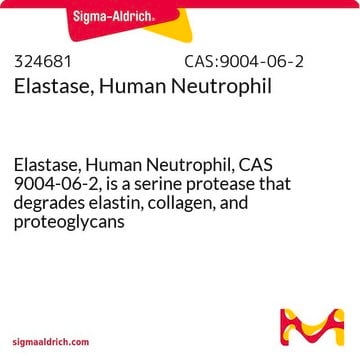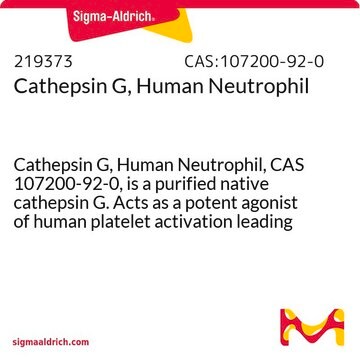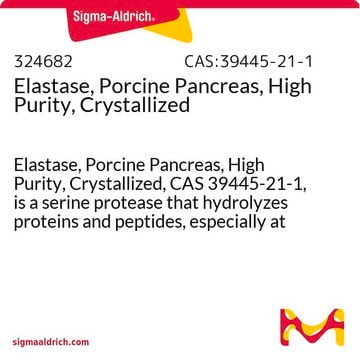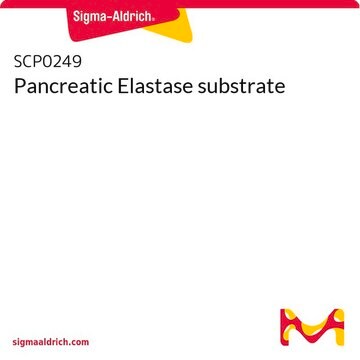E8140
Elastase from human leukocytes
lyophilized powder, ≥50 units/mg protein (Bradford)
Synonym(s):
Lysosomal elastase
Sign Into View Organizational & Contract Pricing
All Photos(1)
About This Item
CAS Number:
MDL number:
UNSPSC Code:
12352204
NACRES:
NA.54
Recommended Products
biological source
human leucocytes
Quality Level
form
lyophilized powder
specific activity
≥50 units/mg protein (Bradford)
mol wt
29 kDa
UniProt accession no.
shipped in
dry ice
storage temp.
−20°C
Gene Information
human ... ELA2(1991) , ELANE(1991)
Looking for similar products? Visit Product Comparison Guide
Related Categories
General description
Elastase is a proteolytic enzyme. It is a member of the subgroup named, peptidyl peptide hydrolases. It is a major anatomic constituent of arteries. It is mainly found in the pancreas and pancreatic juice of various birds and mammals. It is also present in human serum, granulocytes and erythrocytes.
Application
Elastase from human leukocytes has been used:
- to measure serum elastase activity
- in proteolytic digestion of fibronectin and salivary glands
- in neutrophil elastase (NE) activity assay
- cell-free NE digestion of E-cadherin
- scratch wound assay
- in a study that determined that fragments of Nle3-angiotensin(1-7) accelerate healing in dermal models
Biochem/physiol Actions
Elastase enzyme is capable of releasing soluble peptides from insoluble elastin fibers with the help of a proteolytic process. It can stimulate disintegration of the axoneme with the help of adenosine triphosphate (ATP). Unlike pancreatic elastase the leukocyte enzyme has a preferential cleavage for the carboxyl side of valine, but will also cleave to a lesser extent after alanine. Natural substrates include elastin, cartilage proteoglycans, collagen types I, II, II and IV, and fibronectin.
Physical properties
Leukocyte elastase is a 29 kDa serine endoprotease of the Proteinase S1 Family. It exists as a single 238 amino acid-peptide chain with four disulfide bonds. It contains two or thee N-linked glycans of variable composition which account for its three major isoforms.
Isoelectric point: pI = 8.77 - 9.55
Isoelectric point: pI = 8.77 - 9.55
Unit Definition
One unit will release one nanomole of p-nitrophenol per sec from BOC-L-alanine p-nitrophenyl ester at pH 6.5 at 37 °C.
Physical form
Lyophilized from 0.05 M sodium acetate (pH 5.5) and 0.6 M NaCl
Application
Product No.
Description
Pricing
inhibitor
Product No.
Description
Pricing
substrate
Product No.
Description
Pricing
Storage Class Code
13 - Non Combustible Solids
WGK
WGK 1
Flash Point(F)
Not applicable
Flash Point(C)
Not applicable
Certificates of Analysis (COA)
Search for Certificates of Analysis (COA) by entering the products Lot/Batch Number. Lot and Batch Numbers can be found on a product’s label following the words ‘Lot’ or ‘Batch’.
Already Own This Product?
Find documentation for the products that you have recently purchased in the Document Library.
Customers Also Viewed
Maurits L van Montfoort et al.
Arteriosclerosis, thrombosis, and vascular biology, 33(1), 147-151 (2012-10-30)
The formation of neutrophil extracellular traps and the exposure of nucleosomes on these neutrophil extracellular traps contribute to coagulation activation and the propagation of deep vein thrombosis (DVT) in animal models. However, no data are available on the role of
Benjamin J Staudinger et al.
American journal of respiratory and critical care medicine, 189(7), 812-824 (2014-01-29)
Progress has been made in understanding how the cystic fibrosis (CF) basic defect produces lung infection susceptibility. However, it remains unclear why CF exclusively leads to chronic infections that are noninvasive and highly resistant to eradication. Although biofilm formation has
Francisco J Silvestre et al.
Medicina oral, patologia oral y cirugia bucal, 14(8), e365-e370 (2009-03-21)
The purpose of this preliminary study was to monitor the degree of destruction of salivary glands in Sjögren disease by the detection of fibronectin peptides in patients' saliva. The sample consisted of 10 subjects divided in 2 groups, one with
Mathieu Le Gars et al.
American journal of respiratory and critical care medicine, 187(2), 170-179 (2012-12-12)
Cystic fibrosis transmembrane conductance regulator (CFTR) protein is a chloride channel regulating fluid homeostasis at epithelial surfaces. Its loss of function induces hypohydration, mucus accumulation, and bacterial infections in CF and potentially other lung chronic diseases. To test whether neutrophil
Navkiran Gill et al.
PloS one, 7(11), e49646-e49646 (2012-11-17)
The intestinal microbiota has been found to play a central role in the colonization of Salmonella enterica serovar Typhimurium in the gastrointestinal tract. In this study, we present a novel process through which Salmonella benefit from inflammatory induced changes in
Chromatograms
application for HPLCOur team of scientists has experience in all areas of research including Life Science, Material Science, Chemical Synthesis, Chromatography, Analytical and many others.
Contact Technical Service









